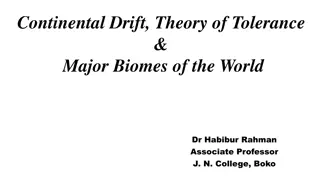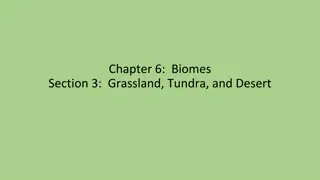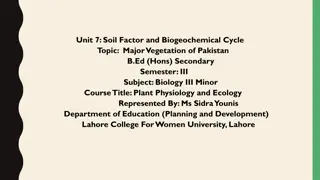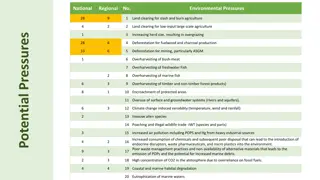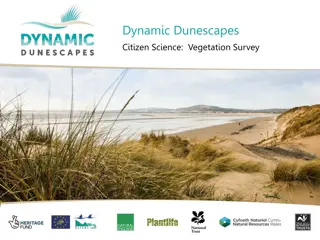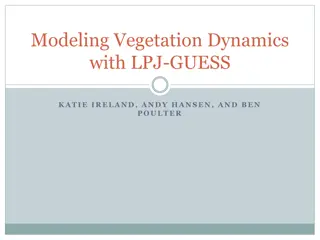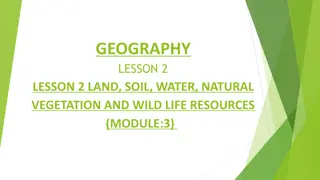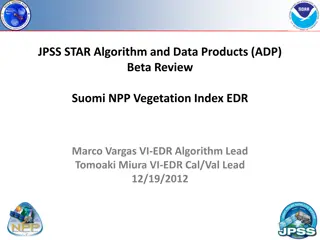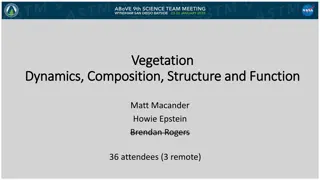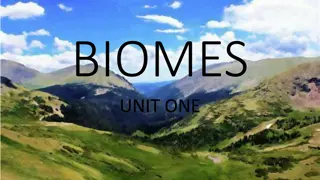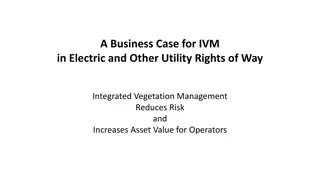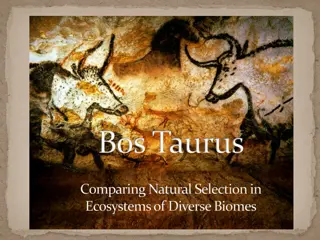Understanding Biomes: Climate, Vegetation, and Adaptations
Biomes are vast regions defined by climate, plant and animal communities. Factors like climate, geography, and vegetation impact the unique characteristics of each biome. Understanding biomes involves knowledge of climate, geography, vegetation adaptations, and animal diversity. Changes in one part of an environment affect the entire ecosystem. Explore the interconnectedness of living things and their surroundings in diverse biomes like deserts, forests, grasslands, tundra, and aquatic environments.
Download Presentation

Please find below an Image/Link to download the presentation.
The content on the website is provided AS IS for your information and personal use only. It may not be sold, licensed, or shared on other websites without obtaining consent from the author. Download presentation by click this link. If you encounter any issues during the download, it is possible that the publisher has removed the file from their server.
E N D
Presentation Transcript
Focus 1/4 1. Get your new vocab sheet and set of notes from the front of the classroom. 2. Answer the following questions on a half-sheet of paper: What are some factors in an environment that make biomes/ecosystems different from one another? Try to come up with at least 2!! Brainstorm using your current/past knowledge: what are the names of some of the biomes?
Chapter 6: Biomes Section 1: What is a Biome?
What is a Biome? Biomes are large regions characterized by a specific type of climate and certain types of plant and animal communities. The climate and geography of a region determines what type of biome can exist in that region. Each biome is made up of many individual ecosystems. Communities within the biome have adapted to the small differences in climate and the environment inside the biome. Major biomes include deserts, forests, grasslands, tundra, and several types of aquatic environments.
What is a biome? -A large area characterized by the climate there as well as the plant and animal communities there -The geography in reference to the equator also affects biomes
More on Biomes All living things are closely related to their environment. Any change in one part of an environment, like an increase or decrease of a species of animal or plant, causes a ripple effect of change in other parts of the environment. Remember, each organism depends in some way on other living and nonliving things in its surroundings.
Biome Information What is Biome?
To understand a world biome, you need to know the following: What the climate of the region is like Where each biome is found and what its geography is like. The special adaptations of the vegetation. The types of animals found in the biome and their physical and behavioral adaptations to their environment.
Biomes and Vegetation Biomes are described by their vegetation because plants that grow in an area determine the other organisms that can live there. Plants in a particular biome have characteristics, specialized structures, or adaptations that allow the plants to survive in that biome. These adaptations include size, shape, and color. For example, plants in the tundra tend to be short because they cannot obtain enough water to grow larger.
Biomes and Climate Climate is the average weather conditions in an area over a long period of time. Climate is the main factor is determining which plants can grow in a certain area, which in turn defines the biome. Temperature and precipitation are the two most important factors that determine a region s climate.
Temperature and Precipitation Most organisms are adapted to live within a particular range of temperatures and will not survive at temperatures too far above or below their range. Precipitation also limits the organisms that can be found in a biome because all organisms need water, and the bigger the animal, the more water it needs.
Temperature and Precipitation Biomes that do not receive enough rainfall to support large trees support communities dominated by small trees, shrubs, and grasses. In biomes where rainfall is not frequent, the vegetation is mostly cactuses and desert shrubs. In extreme cases, lack of rainfall results in no plants, no matter what the temperature is. The higher the temperature and precipitation are, the taller and denser the vegetation is.
Weather versus Climate NASA Explains
Latitude and Altitude Latitude is the distance north or south from the equator, and is expressed in degrees. Altitude is the height of an object above a reference point, such as sea level or the Earth s surface. Climate varies with latitude and altitude. For example, climate gets colder as latitude and altitude increase. This is why it gets colder as you move further up a mountain.
Latitude and Altitude As latitude and altitude increase, biomes and vegetation change. Trees of tropical rainforests usually grow closer to the equator, while mosses and lichen of the tundra grow closer to the poles. The temperate region includes biomes such as temperate forests and grasslands, which usually have moderate temperatures and fertile soil that is ideal for agriculture.
How do latitude and altitude affect biomes? -Greatly effects climate and weather patterns -This in turn effects the plants and animals seen in certain biomes
How do temperature and precipitation affect biomes? - These factors effect the types of plants that can grow in an area which then effects the animals found there
What now? 1. Lets talk about our biome project!!! Due 1/18! 2. Active Reading to be turned in for a grade TODAY 3. Get your textbook, use pages 146-163 to select a biome for your project! Write your biome on a notecard with 3 facts about the biome that your find interesting can be found in your textbook. This will also be turned in!




